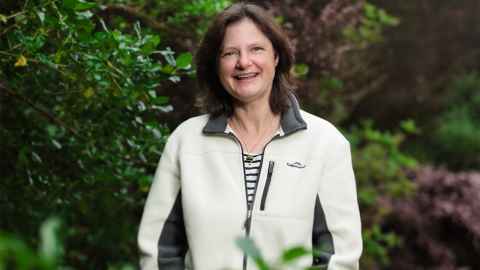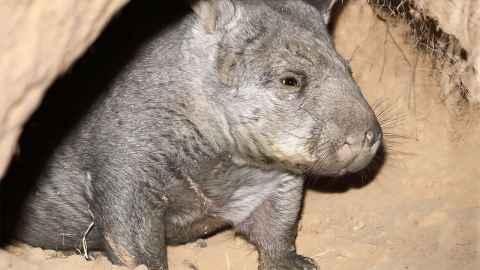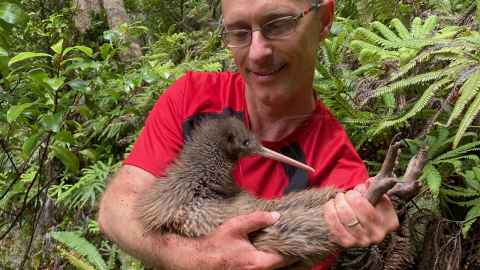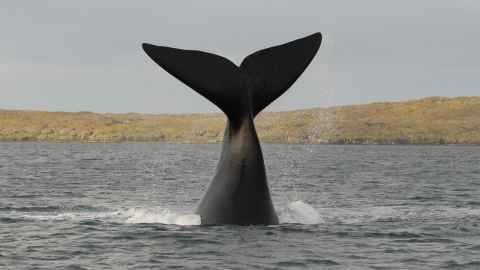Rachel Fewster: saving lives using statistics
4 October 2021
Professor Rachel Fewster tells the story of how statistics and wildlife led to her joyful career.

When Professor Rachel Fewster was on sabbatical during lockdown last year, her research took her on virtual travels.
“One day I was doing statistical analysis for four different projects. There were Bryde’s whales in the Hauraki Gulf, the northern hairy-nosed wombat in Queensland, manta rays in Indonesia and gibbons in Cambodia.
“I got a bit suspicious, so I looked on Google Earth and worked out that from the whales to the wombats the distance was 3,000 kilometres, and from the wombats to the manta rays was 3,000 kilometres. From the manta rays to the gibbons was around the same. I’d made it halfway round the world, all without leaving the house.”
She’s a statistician, so you’ll have to trust the calculations, but why would a statistician be researching creatures all over the world?
That’s a long and lovely story.
“I’ve always been interested in wildlife,” says Rachel, who grew up in Durham in the northeast of England.
“I was switched on to it from around age six or seven. We didn’t have a car so I was a garden naturalist … climbing trees looking for ants! By the time I was 10, I was bird-mad and spent my free time reading nature books and drawing birds.”
Her parents were history academics, coming from a time when you had to choose between arts and science. Rachel leaned towards science but pursued maths, partly due to sibling rivalry.
“I did maths at university because I had a big brother and I was very competitive at that age. We’re all influenced by family and siblings – I have three and I’m the youngest. My brother got a lot of attention from teachers and then went to Cambridge to do maths. I wanted to keep up with him and prove myself. To be fair, I did love maths.”
While doing her MA in maths at Cambridge, she started to wonder how she would use her maths knowledge. “Although I loved it, I couldn’t see myself living with abstraction for my whole life. I wanted to do something a bit more ‘real worldy’.”
She came across a way of combining her two loves, nature and maths.
And the way this came about is another story. While she was still studying, at one point Rachel was volunteering for the Royal Society for the Protection of Birds on a nature reserve in Scotland.
“One day when I was there, we went over to a little island in the Firth of Forth, near Edinburgh, to do conservation work. On the way back, the driver said, ‘If you just go up that way, that’s St Andrews – you might want to visit the town on your day off’.”
Rachel did just that and then, steeled by the naivety of youth, she popped into the University of St Andrews, “to see if they were doing anything that I might be interested in for a PhD”.
“I literally walked off the street into the maths department and said, ‘Hello. I’d like to do a PhD. But what do you do here?’ They were a bit taken aback, but they gave me some information about the sort of research topics they did.”
What Rachel didn’t know was that there was a group of researchers at St Andrews doing exactly what Rachel had dreamt of doing.
“They were using statistics to study natural wildlife populations. I ended up doing my PhD with Professor Steve Buckland there, a world expert in the field.
“So I landed by chance in an area that was really about to take off – statistics and data science. My specialty, the wildlife technology field, has really burgeoned over the past ten years and it’s such an exciting area in which to be working.”

I landed by chance in an area that was about to take off – statistics and data science. My specialty, the wildlife technology field, has really burgeoned over the past ten years.
It was the kākāpō that originally attracted Rachel to New Zealand, in a roundabout way.
“In my third year at Cambridge, a friend and I wanted to do something exciting and decided to go to Australia, but I’d read Douglas Adams’s book Last Chance to See. It has a fantastic chapter about New Zealand and the kākāpō. So I had that in my mind and thought we might ‘pop over’.”
In the end they bypassed Australia and chose New Zealand because of the convenience of being able to travel to its different highlights quickly. The 21-year-olds embarked on the Kiwi Experience, before Rachel headed back to the UK for the PhD at St Andrews. Nearing the end of her PhD, she went to a conference in Australia where she met some New Zealanders and ended up talking about a job advertised in the statistics department at Auckland. When they told her the classes were 300-strong, she was daunted. There’s quite a story behind her application too, but the short version is that in 1999, and somewhat by accident, she got the job and arrived to teach statistics at the University of Auckland.
“It was a shock, I had a huge, to me, stage-one statistics class. The students’ English language levels were quite a bit lower than they are today so communication could be a challenge. But the teaching team led by Matt Regan was incredibly supportive and welcoming. I always felt they valued my input, despite my new-fangled and, quite frankly, often ridiculous ideas about how things should be taught.
“That stage one stats team was one of the best and most collegial teams I’ve ever experienced. It won a National Tertiary Teaching Excellence Award in 2003, for excellence in collaboration.”
Rachel also won a national award for Sustained Excellence in Tertiary Teaching in 2009, and the NZ Statistical Association’s Campbell Award in 2018. Her enthusiasm for her subject blows the stereotype of the crusty mathematician out of the water and has been described as the “Fewster effect”. Her love of subject exudes from her inaugural lecture – if you want to be fascinated, educated and amused it’s on YouTube (see link below).
In it, Rachel touches on one serious note, that she alludes to in our interview as well. It’s the business of becoming a professor and how the prerequisites (all science academics must publish 80 papers) don’t fit with all fields of research. She was rejected twice for professorship at Auckland before being offered a chair at a high-ranking university overseas, which seemed to propel the wheels of promotion at Auckland in a more favourable direction.
“I’m not a fan of the current promotion procedures. They’re off-kilter in terms of catering to different subject areas and I hope that’s something that can be addressed.
“My research profile is so different from the rule book and there will be other people like me. To retain good staff in New Zealand universities, I think we should be looking at more flexible pathways. What is happening is that it shuts out a certain sector of people who do very high-quality, innovative work, but don’t have fast throughput.”
Some populations of kiwi have little recorders fixed to their collars. But even then you can’t be absolutely sure it’s that bird that’s yelling, and not another one. They could be standing next to each other.

Rachel is working on three Marsden-funded projects, and is the principal investigator on two of those. One involves remote sampling of birds like kiwi using microphones, spaced a certain distance apart to pick up their calls. It’s not as simple as it sounds, but the team is making good progress and using a similar methodology to estimate population numbers in bats, ruru and even fish.
She says monitoring bird sounds, no matter what measure you use, can be fraught.
“Some populations of kiwi have little recorders fixed to their collars. But even then you can’t be absolutely sure it’s that bird that’s yelling, and not another one. They could be standing next to each other.”
And then she shatters the image of the ‘cute little kiwi’ most of us have etched in our minds.
“Kiwi are very aggressive birds. They can’t abide each other. They’re furious with each other!”
You don’t want to worsen their mood when monitoring them. “As statisticians, what we love to be able to do is use non-intrusive methods that don’t create stress.”
She says they also have volunteers listening for kiwi bird calls. The quiet of lockdowns doesn’t need to impact that research, nor does the fact the volunteer might be going a bit deaf.
That’s because a statistician’s role is to devise ways to count what they can’t see or hear.
“For every animal you see or hear, you simultaneously collect information about the chance you missed it,” says Rachel. “It’s the way the whole statistical framework operates. It doesn’t matter if you hear more birds in lockdown. The maths sorts it out.”
Other statistical analysis she’s involved in is with whales. As well as the Bryde’s whales, she’s helping with research on the New Zealand tohorā (southern right whale) population, analysing data supplied by the Tohorā Research Team. Its 2020 research trip to the Subantarctic Auckland Islands, led by Dr Emma Carroll with Associate Professor Rochelle Constantine (Biological Sciences), has provided a wealth of population data.
With whales, if surveyors get lucky they can get a photograph that will identify the whale. Alternatively they might obtain a DNA sample through a painless dart.
“But that can be difficult, and requires researchers to reinvent themselves as sharpshooters. Plus, if there’s more than one whale around, you can’t be 100 percent sure your dart has hit the one you thought it did.”
Still, the visual identification of whales has led to a bit of fun for the surveyors whose work is a mix of mathematical formulae and statistical probability. The tohorā researchers now know one whale by distinctive protrusions on its back, so that whale has been named Knobbly-Back. Another with a zig-zag white pigmentation has been named Harry, as in Harry Potter who has a scar on his forehead. Logically, other whales have become Ron and Hermione.
Rachel’s other statistical work includes the northern hairy-nosed wombat in Queensland. With the wombats, and the aforementioned gibbons and manta rays, she is sent the data from afar and applies her statistical analytical skills.
“The northern hairy-nosed wombat is one of my favourite projects. It’s one of the world’s rarest land mammals. They only live in one reserve in Queensland, but some have now been translocated to another reserve and we reckon we’ve just made it to 300 wombats.”

To retain good staff in universities, we should be looking at more flexible pathways. What is happening is that the current system shuts out a certain sector of people who do very high-quality, innovative work, but don’t have fast throughput.
Despite all the interesting research data she is sent, Rachel still enjoys her core role – making statistics more engaging to students. This year she has enjoyed developing a new capstone course.
“Students work in teams and we set them mini-project challenges, each lasting a week. And we’re seeing incredible results where students develop their independence, their initiative, their teamwork, their collegiality. It’s so rewarding.
“It’s a great way to develop students and expose them to different modes of statistical communication. For example, we might say, ‘your audience this week is the Minister of Police, or this week it’s high-school students’. It’s great for them to think about how they need to communicate differently to different audiences.”
Speaking of different audiences, Rachel is the driving force behind CatchIT, a data and analysis tool for community conservation projects. A small team of students and staff run the project and there’s also a CatchIT Schools programme. She says communities are crucial in controlling rats, possums and stoats, trapping these whenever possible. But rats can swim, so pest-free islands can be quickly overrun.
“Stoats swim too. Stoats are the nastiest predator out there, in terms of being both numerous and vicious killing machines. They’re the number one enemy.”
Somehow a stoat, or more than one, has found its way to Motutapu Island.
“We don’t know how, and we don’t know how many are there,” says Rachel. “DOC did catch a couple of males in 2020 but droppings show us that there’s at least one more.”
It will be worse news if that stoat is female.
“Female stoats are always pregnant, because of their unique embryo development. Male stoats will impregnate even a baby stoat when it’s a tiny nestling, and the fertilised embryos can implant many months later. So if a female stoat gets to Motutapu, it’s really bad news. They have to be trapped or detected by dogs. It’s not easy.”
She says the best guess for the origin of the stoats is from the Tāmaki River, or alternatively Takapuna or Devonport. “We think they’re swimming or being swept by floodwaters.”
Now there’s a push to get stoat samples from around Auckland to see if researchers can nail down the origin of the stoats and how they’ve ended up on the island using clues in the DNA. Covid-19 isn’t the only thing that needs eliminating in New Zealand.
Denise Montgomery
This story first appeared in the October 2021 edition of UniNews.